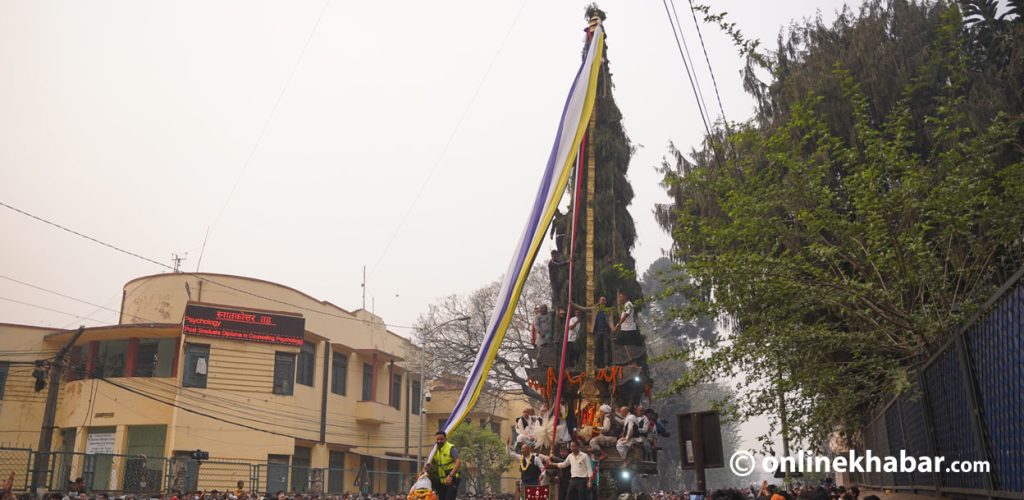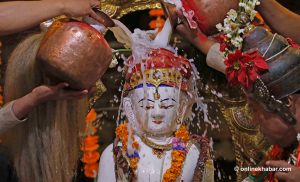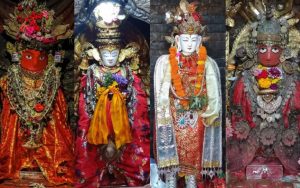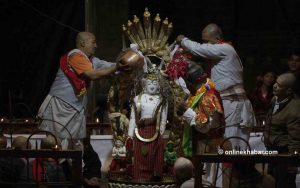
Ram Kaji Shrestha, 49, is making sure the chariot of Seto Machhindranath, a deity worshipped by Hindus as the god of rain and Buddhists as Awalokiteshwor, is ready by Sunday.
He has been volunteering to build the chariot which stands high at Durbar Marg for the last decade. He does this because he feels the good deed will grant him happiness in life. “My father used to do it too. He always told me that if we help build the chariot good things will happen to us and we will live longer and if I look back I think he was right as he lived for 93 years,” says Shrestha.
The chariot is prepared by the members of the guthi about 10 days before the festival. Shrestha along with eight other members of the guthi are building the chariot. “For building the chariot, we will all receive the blessing of Jana Baha Dyah (Seto Machindranath) who has been looking after us and our family for generations,” he adds as he observes others to make sure that there are no problems with the 30-foot-high chariot.

There are numerous myths as to why the festival is celebrated. For many, the celebration simply marks the end of winter and the beginning of the spring and rainy seasons. Locals at Jana Bahal, the temple where the idol of Seto Machindranath is kept, have their own stories. One of the most popular myths has to do with Yamaraj, the god of death and his visit to Swyambhunath.
According to the myth, Lord Seto Machhindranath appeared in a pond near present-day Ranipokhari, during the reign of Yaksha Malla. Here’s how the story goes: having heard a lot about Swayambhunath and its mystical powers Yamaraj came to visit the holy place so he too could go to heaven one day. As he was returning back, the king, with help from his tantric priest, captured the god of death and demanded that he make him immortal in return for his freedom. A mortal god himself, Yamraj told the king that he couldn’t give anyone that power. The king didn’t let him go. Yamraj summoned Lord Arya Awalokiteshwor, a manifestation of Bodhisattva, to free him from the king.
The lord, white in colour, emerged from the water and told the king that neither Yamaraj nor he could grant him immortality. The lord also told him to build a temple where the Kalmati and Bagmati rivers met. “Anyone who visits the temple will live a long life, that’s all I can do,” the lord is said to have told the king, who had no other option but to free Yamaraj.
He also told the king to organise a ratha yatra every year for three days starting from Chaitra Sukla Ashtami (this Sunday) so that he could go to the houses of those people who cannot move, because of disability or stay longer in their houses and to bless them. Ever since then, the procession takes place every year from the same place where the lord presented himself to King Yaksha Malla.
The Chariot
During the festival, the idol of Seto Machhindranath is removed from his temple at Jana Baha and carried in a palanquin to Durbar Marg from where the actual procession starts. There it is installed in the car built in the shape of a tower on wheels.
The four huge wheels of the chariot, each represents separate avatars of Bhairav. The chariot has 10 storeys, which are believed to be the houses of lords Indra, Barun, Kuber, Agni, Nairithya, Bayubya, Bramha, Mahadev, and Narayan, respectively.

The idol of Seto Machindranath is perched on the first storey of the chariot. The section, decorated with precious stones, is supposed to be guarded by two other idols of two avatars of Goddess Tara.
The procession
As the image is placed on the chariot, musicians play their long trumpets to announce the installation. A ceremonial guard of honour is then given by soldiers dressed in ancient uniforms who perform rifle salute with their muskets.

The crowd then pulls the chariot through central Kathmandu accompanied by musical bands.
The Route
On the first day, the chariot is pulled from Jamal, Durbar Marg through Bhotahiti to Asan where it makes an overnight halt. The next day, the chariot is taken to Indra Chok and Kathmandu Durbar Square where it makes its second stop.
On the third day, it is pulled through Maru and Chikan Mugal to Lagan at the southern end of the historic section of Kathmandu. There the procession ends after the chariot makes three rounds of the temple housing the mother of Janabaha Dyo.
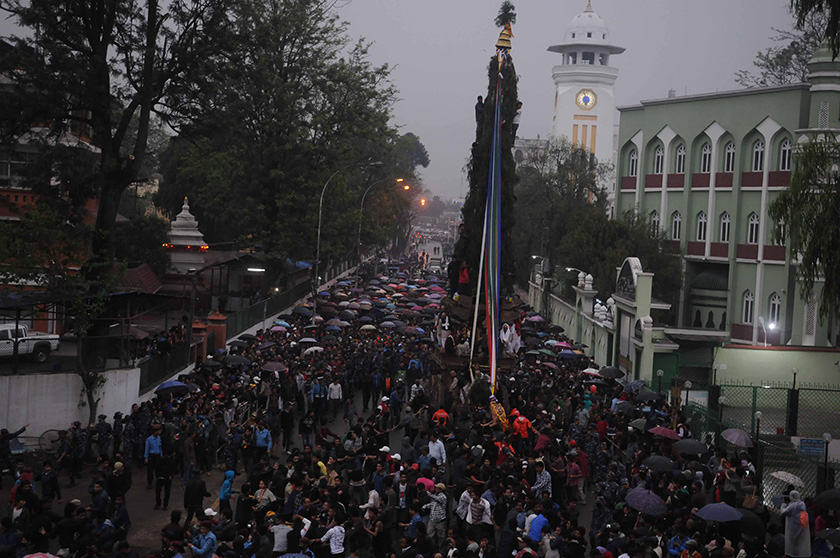
Worshippers bring trays of offerings and light rows of butter lamps to honour the deity wherever the chariot stops.
On the fourth day, after a special puja, the idol is carried back to the temple. The chariot is disassembled and the parts stored for next year.






